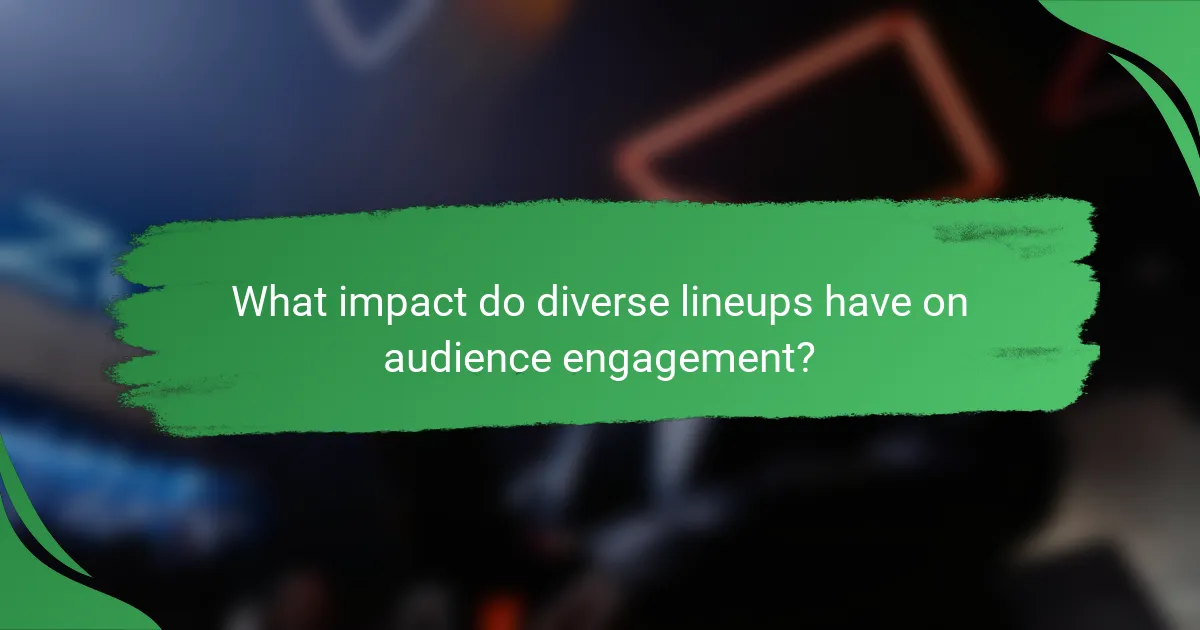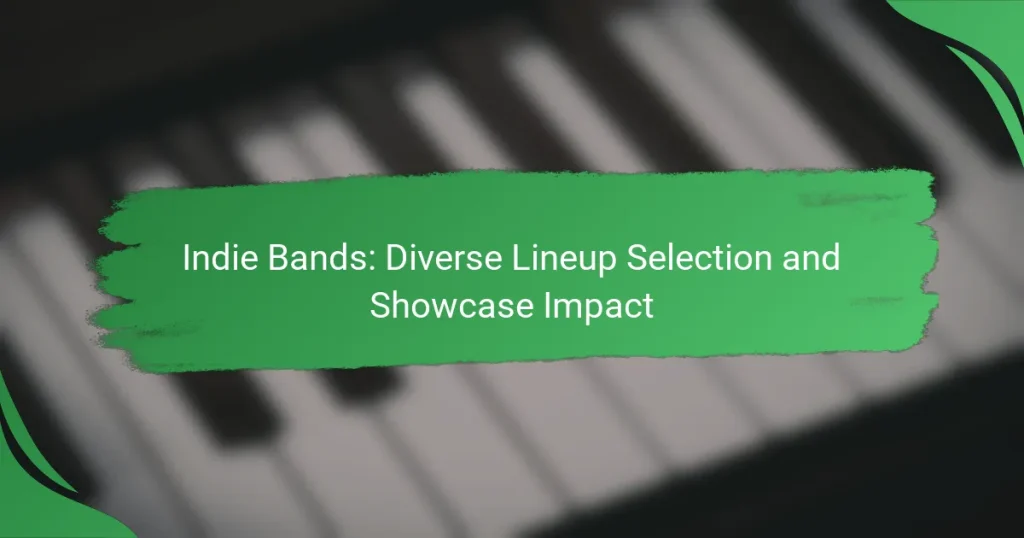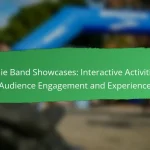Selecting a diverse lineup of indie bands for showcases is crucial for creating an engaging and inclusive atmosphere. By considering factors such as genre, local talent, and audience preferences, organizers can attract a broader audience and enhance the overall experience. This strategic approach not only satisfies varied musical tastes but also encourages interaction among fans, fostering a vibrant community around the event.

How to select diverse indie bands for showcases?
Selecting diverse indie bands for showcases involves considering various factors such as genre, local talent, audience preferences, cultural influences, and past performance success. A well-rounded lineup not only attracts a broader audience but also enriches the overall experience of the event.
Consider genre variety
Incorporating a mix of genres can significantly enhance the appeal of your showcase. Aim for a lineup that includes rock, pop, folk, electronic, and hip-hop to cater to different musical tastes. This diversity can attract a wider audience and create a more dynamic atmosphere.
When selecting bands, think about how different genres can complement each other. For example, pairing an upbeat pop act with a more introspective folk artist can create an engaging contrast that keeps the audience interested throughout the event.
Evaluate local talent
Supporting local indie bands is crucial for fostering community engagement and building a loyal audience. Research local music scenes to identify emerging artists who have a strong following or unique sound. This not only promotes local culture but also helps in creating a sense of belonging among attendees.
Consider hosting auditions or open calls for local bands to showcase their talent. This approach can uncover hidden gems and provide opportunities for artists who may not have access to larger platforms.
Assess audience preferences
Understanding your audience’s musical preferences is essential for selecting the right bands. Conduct surveys or polls to gather insights on the types of music your target demographic enjoys. This data can guide your selection process and ensure that the lineup resonates with attendees.
Additionally, consider the demographics of your audience. For instance, if your showcase attracts a younger crowd, incorporating popular genres like electronic or indie pop may be more effective than focusing solely on traditional rock acts.
Incorporate cultural influences
Integrating cultural influences into your lineup can create a richer experience for attendees. Look for bands that represent various cultural backgrounds or incorporate traditional elements into their music. This not only celebrates diversity but also educates the audience about different musical traditions.
For example, featuring a band that blends folk music with contemporary styles can introduce audiences to new sounds while keeping the performance accessible and engaging.
Analyze past performance success
Reviewing the past performance success of bands can provide valuable insights into their potential impact at your showcase. Look for metrics such as audience turnout, engagement levels, and social media buzz from previous shows. Bands with a proven track record are often more likely to draw crowds and create memorable experiences.
Consider creating a shortlist of bands that have consistently performed well in similar settings. This can help you make informed decisions and avoid the pitfalls of selecting artists who may not resonate with your audience.

What impact do diverse lineups have on audience engagement?
Diverse lineups significantly enhance audience engagement by attracting a wider range of attendees and fostering a more inclusive atmosphere. This variety not only satisfies different musical tastes but also encourages interaction among fans of various genres.
Increases audience satisfaction
A diverse lineup caters to multiple musical preferences, leading to higher audience satisfaction. When attendees find artists they love, they are more likely to enjoy the overall event and return for future shows.
For instance, a festival featuring rock, hip-hop, and electronic acts can appeal to fans from each genre, creating a more enjoyable experience for everyone involved.
Enhances overall event experience
Events with diverse lineups often create a vibrant atmosphere that enhances the overall experience. The mix of styles and cultures can lead to unique collaborations and performances that captivate audiences.
Moreover, diverse acts can engage attendees through various visual and auditory elements, making the event memorable and encouraging social sharing, which boosts its visibility.
Encourages cross-genre exploration
Diverse lineups encourage attendees to explore genres they may not typically listen to. This exposure can lead to a broader appreciation of music and the discovery of new favorite artists.
For example, a fan of indie rock might find themselves enjoying a set by a local jazz band, expanding their musical horizons and fostering a more inclusive music community.
Boosts ticket sales
Having a diverse lineup can significantly boost ticket sales by appealing to a larger audience. Festivals and concerts that feature a variety of genres tend to attract more attendees, as fans are drawn to the prospect of seeing multiple artists in one event.
Promoters should consider marketing strategies that highlight the diversity of the lineup to maximize ticket sales, such as targeted advertising to different music communities and social media campaigns that showcase the range of performers.

What are the best practices for showcasing indie bands?
Showcasing indie bands effectively involves strategic planning and community engagement. Key practices include leveraging social media, connecting with local music communities, offering merchandise, and ensuring high-quality sound and lighting.
Utilize social media promotion
Social media is a powerful tool for promoting indie bands and their showcases. Platforms like Instagram, Facebook, and Twitter allow bands to reach a wider audience and engage directly with fans. Regular updates, behind-the-scenes content, and event announcements can significantly boost visibility.
Consider creating event pages and using targeted ads to reach specific demographics. Engaging with followers through polls or Q&A sessions can also enhance interaction and build a loyal fan base.
Engage with local music communities
Connecting with local music communities is crucial for indie bands to gain support and exposure. Attend local shows, participate in open mics, and collaborate with other artists to build relationships. This grassroots approach can lead to valuable networking opportunities and shared audiences.
Joining local music groups on social media or forums can provide insights into upcoming events and trends. Additionally, partnering with local venues can help establish a presence in the community and attract more attendees to showcases.
Offer merchandise opportunities
Merchandise can be a significant revenue stream for indie bands while enhancing their brand. Offering items like T-shirts, stickers, and vinyl records at showcases not only generates income but also helps fans feel connected to the band. Consider creating limited edition items for special events to entice purchases.
Set up an easy-to-navigate online store to complement in-person sales, allowing fans to buy merchandise even after the event. Ensure that pricing is reasonable, keeping in mind local market standards, to encourage sales.
Provide professional sound and lighting
High-quality sound and lighting are essential for creating an enjoyable experience at indie band showcases. Invest in professional audio equipment and hire experienced sound engineers to ensure that performances are heard clearly and at the right volume. Poor sound quality can deter audiences from returning.
Lighting also plays a crucial role in setting the mood and enhancing performances. Use a mix of ambient and stage lighting to create an engaging atmosphere. If budget allows, consider hiring a lighting technician to design a setup that complements the music style and venue layout.

How do indie bands benefit from diverse showcases?
Indie bands gain significant advantages from participating in diverse showcases, as these events enhance visibility and foster connections within the music industry. By performing alongside varied artists, bands can reach new audiences and create valuable relationships that may lead to future opportunities.
Expand their fan base
Diverse showcases allow indie bands to perform in front of audiences that may not be familiar with their music. By sharing the stage with artists from different genres or backgrounds, bands can attract new listeners who appreciate variety and are open to discovering fresh sounds.
For instance, a rock band participating in a showcase with folk and electronic artists can tap into the fan bases of those genres. This cross-pollination can lead to increased social media followers and streaming numbers, helping to build a broader audience over time.
Network with other artists
Networking is a crucial aspect of the music industry, and diverse showcases provide an ideal environment for indie bands to connect with other musicians. These events often foster collaboration opportunities, allowing bands to share ideas, resources, and even co-create music.
Engaging with artists from different backgrounds can inspire creativity and innovation. Bands should take advantage of these interactions by exchanging contact information and following up after the event to explore potential partnerships.
Gain exposure to industry professionals
Participating in diverse showcases can attract industry professionals such as talent scouts, booking agents, and record label representatives. These individuals often attend such events to discover new talent, making it a prime opportunity for indie bands to make a lasting impression.
To maximize exposure, bands should prepare a strong performance and have promotional materials ready, such as business cards or digital press kits. Following up with industry contacts after the showcase can also help solidify relationships and open doors for future gigs or recording opportunities.

What are the criteria for evaluating indie bands?
Evaluating indie bands involves assessing their musical talent, originality, stage presence, and performance skills. These criteria help determine the band’s potential impact and appeal in the competitive music landscape.
Musical talent and originality
Musical talent refers to the technical skills of the band members, including their proficiency with instruments and vocal abilities. Originality is crucial in distinguishing a band from others; it encompasses unique songwriting, innovative sound, and creative arrangements.
When evaluating musical talent, consider factors such as the complexity of compositions and the ability to play in various styles. Originality can be assessed through the band’s repertoire and how they blend different genres or influences.
For example, a band that successfully combines folk elements with electronic music may stand out more than one that follows traditional rock formulas. Look for bands that push boundaries and offer fresh perspectives in their music.
Stage presence and performance skills
Stage presence is the ability of a band to engage and captivate an audience during live performances. Performance skills include not only musicianship but also how well the band interacts with the crowd and conveys energy.
Effective stage presence can be evaluated by observing the band’s confidence, charisma, and ability to connect with the audience. A band that encourages audience participation or creates a dynamic atmosphere is likely to leave a lasting impression.
To assess performance skills, consider factors such as timing, coordination, and the overall cohesiveness of the band during live shows. Bands that can deliver a polished performance while maintaining authenticity often resonate better with fans.


